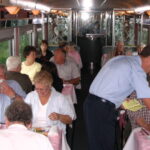Amtrak: A Food Desert on Rails?
by Matt Melzer
Train travel naturally fits healthy communities, offering low-stress, low-emission, human-scale transportation between city and town centers to people of diverse physical abilities and economic means. It literally complements a balanced diet. Yet Amtrak’s recent experiments in food service cuts on the Capitol Limited and Lake Shore Limited portend a nastier, brutish experience with the caliber of meal choices you’d find at the average bus station, Interstate Highway offramp, or smaller airport.
Nearly one-quarter of Americans live in a food desert as defined by the USDA. The American Nutrition Association notes, these areas are “short on whole food providers, especially fresh fruits and vegetables” and are “heavy on local quickie marts that provide a wealth of processed, sugar, and fat laden foods that are known contributors to our nation’s obesity epidemic.” These conditions largely owe to lack of access to transportation, plus farm subsidies to corn and soy growers which make junk food cheap.
In the case of Amtrak’s national network trains, as a microcosm of society, coach passengers are more likely to bring their own food and/or purchase food from the cafe car. The latter has long been devoid of many healthy choices (this is slowly changing on certain regional routes). The full-service diner is a bastion not of only of conviviality, but also nourishment.
By Amtrak’s own accounting, the calories, fat, cholesterol, and sodium content of the Antipasto Plate, one of the new meals for Capitol and Lake Shore sleeper passengers, meet the textbook definition of food-desert junk food. You might think the Vegan Wrap is a more prudent choice, but it still has 80% of the Daily Value for fat and sodium. At breakfast, with the single option, you’re facing 60% of the DV of carbohydrates, 85% of cholesterol, and nearly as much fat as the Antipasto.
Amtrak’s PR-driven touting of these new meals as “contemporary” may highlight an unintentionally ironic truth about the state of food in America. Amtrak’s Food Facts site lays bare the differences between cooked food and processed food. Even offerings on routes with off-site-prepped hot food such as the Cardinal and Acela Express are relatively healthier while still pleasing a range of palates.
Observers have long noted that Amtrak’s diner food is very traditionally American and wondered why Amtrak can’t offer more middle-ground options (in terms of price point, service model, and nutritional profile).
Amtrak is now at a decision point for how it positions itself in the transportation market. In the next installment, I’ll explore some of the ways Amtrak can again use food service to appeal to broad audiences instead of viewing it as a pure cost center.




I agree. I found this site by searching “Amtrak food desert”. The on-board cafe options are atrocious, resembling fast-food entries. On the Crescent, which recently dropped its dining car, the remaining food choices include too much sugar, cheese, and fried items, and very little (if any) fruit or salads, let alone palatable real entrees. A passenger using the train as an actual point-to-point mode of transportation might be on board for 30 hours (or more given a late arrival). In that period, it’s necessary to be able to purchase a real nutritious meal. Why, Amtrak, why?
Screwed up priorities. The U.S. government chooses to subsidize highways and airlines and all other forms of public transportation right on down to bike lanes, but inter-city passenger rail has to fight for every dime.